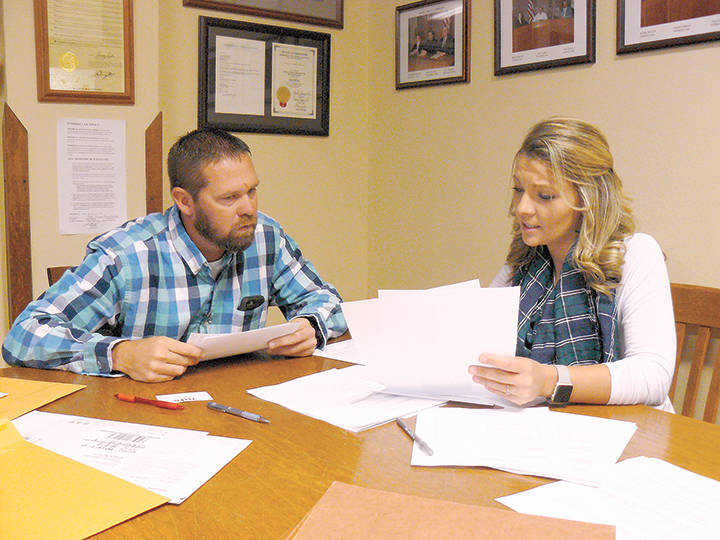Phase two bids opened

Bids for phase two work on restoration of the Vernon County courthouse were opened and reviewed Wednesday morning, in the chambers of the Vernon County Commission.
“We will not be awarding any contracts today,” said Joe Hardin, presiding commissioner, in the moments prior to the opening. “We will have to look at each of them and determine if we need to ask any questions of the bidders or need to modify the bid request and ask for a re-bid or if we can accept one or more of them as is,” said Hardin.
As with the prior work, the grant for phase two is being provided by Missouri’s State Historic Preservation Office.
As stated in the grant, which was written and will be administered on the county’s behalf by the Clinton based Kaysinger Basin Regional Planning Commission, the purpose is “to make repairs to the exterior roofing, masonry and drainage system of the Vernon County Courthouse.”
As stated in the grant application, the scope of the project is to include:
• Installation of new downspouts and underground drainage systems to curbs;
• Installation of lead T-caps in horizontal masonry joints (glued into joints to keep out water);
• Repointing of stone gables;
• Repointing and brick replacement at interior of clock tower;
• Removal of all interior delaminated plaster (plaster pulling away from the lath behind it);
• Exterior sealing of the joint between masonry and window frames;
• Interior sealing of window frames;
• Repair/replacement of roof flashing at stone gables;
• Repair of the brick face on the interior side of masonry walls;
• Replacement of the removed interior plaster with historic plaster after moisture in the masonry walls has been reduced to acceptable levels.
Two firms bid to be project architect while five submitted bids on the roofing, masonry and drainage. Of those five, four bid on one or more pieces of the project with only one company submitting a bid for all of the work.
The sole complete bid was submitted by Pishny Restoration Services of Lenexa, Kan., the firm which performed all of the work in the first phase.
The phase two grant application listed the total cost as $115,000.
Said Hardin, “This is being done on a 70/30 basis, so $80,500 of that will be grant money with the balance being paid by the county.”
While broken down into sections which included optional work, Pishny’s bid for phase two work totaled $230,550. While Pishny’s bid included the use of a subcontractor to perform the drainage work and that subcontractor bid the same work at a lower price, still a price of over $225,000 is well over the available $115,000.
“And we have to keep just over $5,000 of that back to pay for the architect and grant administrator,” said Hardin. “So there is no way we can get everything done in this round.”
On hand for the bid opening was Cassie Sanders with Kaysinger. She applied for and administered the state grants on behalf of the county. While commissioners were away for other appointments in the early afternoon, Sanders had been delegated to obtain a breakdown of numbers and further information from several contractors.
By late Wednesday, commissioners had prioritized the work it wanted to complete in the second phase. Awaiting further information, they will likely award contracts next week.
“They have until Nov. 14 to make a decision and notify the state,” said Sanders.
The prioritized work includes installation of new downspouts and the underground drainage system to the curbs, installation of lead T-caps in horizontal masonry joints, the repointing of stone gables; repointing and brick replacement for the clock tower’s interior and removal of all interior delaminated plaster.
Still to be decided is how much of the sealing around the windows, whether exterior or interior, will be performed.
Having been prepared for there to be a difference between what the architect and contractors say a project should cost, the commission had set aside a limited additional amount for this project.
Motioning to his fellow commissioners, seated on either side of him, Hardin said, “We are very mindful that when it comes to going beyond the grant, these are taxpayer dollars we’re talking about. But we also realize that certain repairs need to be made to the courthouse in order to stop the exterior water problems which are causing all the problems we’ve got inside the building.”
The grant calls for completion by the end of 2018 with Hardin adding, “Like everything we do, it’s a case of weather permitting. So, sometime next spring work will get underway and sometime by the fall the work will be completed. This is a beautiful courthouse and we want to preserve it for the next generation.”
Shortly after the start of the state’s fiscal year in July, Sanders told commissioners the governor’s office had put a freeze on the State Historic Preservation Office making further grants for the time being.
“From what I’ve heard, they may be allowed to take grant proposals as early as January with awards being made by the end of 2018 for work to be done in 2019,” said Sanders.
In what is planned to be the final phase of the courthouse restoration project, work would complete what remains from the second phase plus the removal of peeling paint and the repainting of the walls and ceilings in the stairways and halls as well as those rooms whose walls will be re-plastered.
